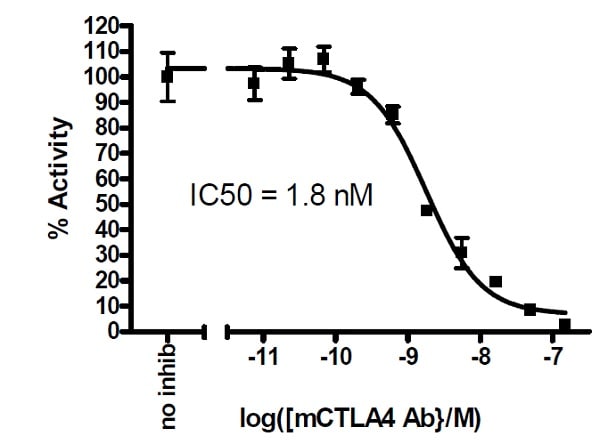Recombinant mouse CTLA4 protein (Active) (Biotin) (ab271481)
Key features and details
- Expression system: HEK 293 cells
- Purity: >= 90% SDS-PAGE
- Active: Yes
- Tags: Avi tag C-Terminus, Fc tag C-Terminus
- Suitable for: Functional Studies, SDS-PAGE
-
Product name
Recombinant mouse CTLA4 protein (Active) (Biotin)
See all CTLA4 proteins and peptides -
Biological activity
Recombinant Mouse CTLA4 protein (Active) (Biotin): B7-1 TR-FRET IC50 = 1.8 nm.
-
Purity
>= 90 % SDS-PAGE. -
Expression system
HEK 293 cells -
Accession
-
Protein length
Protein fragment -
Animal free
No -
Nature
Recombinant -
-
Species
Mouse -
Sequence
EAIQVTQPSVVLASSHGVASFPCEYSPSHNTDEVRVTVLRQTNDQMTEVC ATTFTEKNTVGFLDYPFCSGTFNESRVNLTIQGLRAVDTGLYLCKVELMY PPPYFVGMGNGTQIYVIDPEPCPDSD -
Predicted molecular weight
42 kDa -
Amino acids
36 to 161 -
Tags
Avi tag C-Terminus , Fc tag C-Terminus -
Additional sequence information
Extracellular domain fused to the Fc portion of human IgG1.
-
-
Conjugation
Biotin
Preparation and Storage
-
Alternative names
- ALPS5
- CD
- CD 152
see all -
Function
Inhibitory receptor acting as a major negative regulator of T-cell responses. The affinity of CTLA4 for its natural B7 family ligands, CD80 and CD86, is considerably stronger than the affinity of their cognate stimulatory coreceptor CD28. -
Tissue specificity
Widely expressed with highest levels in lymphoid tissues. Detected in activated T-cells where expression levels are 30- to 50-fold less than CD28, the stimulatory coreceptor, on the cell surface following activation. -
Involvement in disease
Genetic variation in CTLA4 influences susceptibility to systemic lupus erythematosus (SLE) [MIM:152700]. SLE is a chronic, inflammatory and often febrile multisystemic disorder of connective tissue. It affects principally the skin, joints, kidneys and serosal membranes. SLE is thought to represent a failure of the regulatory mechanisms of the autoimmune system.
Note=Genetic variations in CTLA4 may influence susceptibility to Graves disease, an autoimmune disorder associated with overactivity of the thyroid gland and hyperthyroidism.
Genetic variation in CTLA4 is the cause of susceptibility to diabetes mellitus insulin-dependent type 12 (IDDM12) [MIM:601388]. A multifactorial disorder of glucose homeostasis that is characterized by susceptibility to ketoacidosis in the absence of insulin therapy. Clinical fetaures are polydipsia, polyphagia and polyuria which result from hyperglycemia-induced osmotic diuresis and secondary thirst. These derangements result in long-term complications that affect the eyes, kidneys, nerves, and blood vessels.
Genetic variation in CTLA4 is the cause of susceptibility to celiac disease type 3 (CELIAC3) [MIM:609755]. It is a multifactorial disorder of the small intestine that is influenced by both environmental and genetic factors. It is characterized by malabsorption resulting from inflammatory injury to the mucosa of the small intestine after the ingestion of wheat gluten or related rye and barley proteins. In its classic form, celiac disease is characterized in children by malabsorption and failure to thrive. -
Sequence similarities
Contains 1 Ig-like V-type (immunoglobulin-like) domain. -
Post-translational
modificationsN-glycosylation is important for dimerization.
Phosphorylation at Tyr-201 prevents binding to the AP-2 adapter complex, blocks endocytosis, and leads to retention of CTLA4 on the cell surface. -
Cellular localization
Cell membrane. Exists primarily an intracellular antigen whose surface expression is tightly regulated by restricted trafficking to the cell surface and rapid internalisation and. - Information by UniProt
Images
-
Recombinant Mouse CTLA4 protein (Active) (Biotin): B7-1 TR-FRET IC50 = 1.8 nm.
-
SDS-PAGE analysis of 2 µg ab271481.
This protein runs at a higher MW by SDS-PAGE due to glycosylation.








